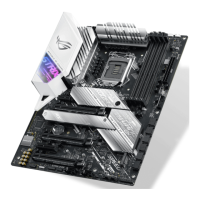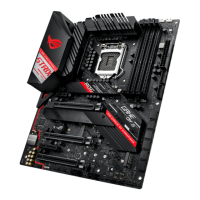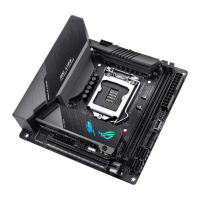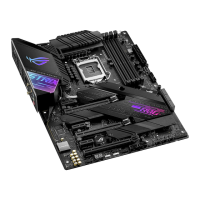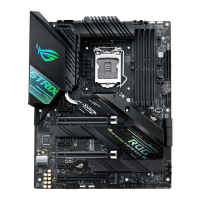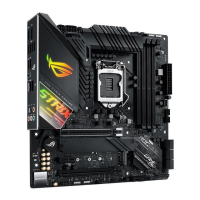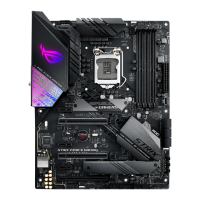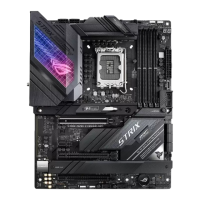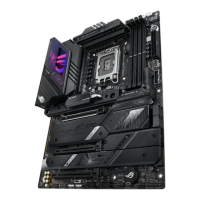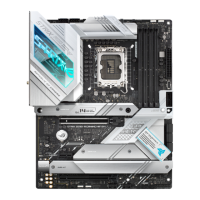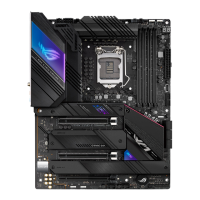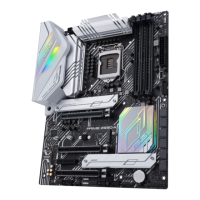Do you have a question about the Asus ROG STRIX Z490-E and is the answer not in the manual?
Instructions to enter BIOS during Power-On Self Test (POST).
Methods to enter BIOS after the system has started POST.
Describes the two main modes of the BIOS setup program: EZ Mode and Advanced Mode.
Details how to change the system security settings.
Enhances power saving for PCI Express and performs ASPM operations.
Controls Active State Power Management for DMI Link and PEG.
Selects the ASPM state for energy-saving conditions.
Selects PCI Express L1 Substates settings for power saving.
Enables or disables PCI Express Clock Gating for each root port.
Enables or disables Software Guard Extensions (SGX).
Sets TCC Offset Time Window for the RATL feature.
Enables virtualization technology function on the memory control hub.
Enables 64-bit capable devices to be decoded in above 4G address space.
Configures the PCI Express slots' speed.
Enables or disables individual SATA controllers.
Sets the SATA configuration mode (AHCI or RAID).
Supports link power management for energy saving.
Monitors hard disk health during POST.
Enables or disables specific SATA ports.
Enables or disables SATA hot plug support.
Enables or disables PTT (Platform Trust Technology).
Enables or disables Discrete Thunderbolt(TM) Support.
Enables booting from bootable devices via Thunderbolt.
Enables or disables Titan Ridge Workaround for OSUP.
Enables or disables Tbt Dynamic AC/DC L1 support.
Enables or disables system wake from Thunderbolt devices.
Selects the security level for Thunderbolt devices.
Generates software SMI for resource assignment to TBT devices.
Generates ACPI Notify for Thunderbolt hot-plug.
Enables or disables Single Root IO Virtualization Support.
Supports USB devices in legacy operating systems.
Manages EHCI support via XHCI drivers.
Enables or disables individual USB ports.
Enables or disables the UEFI network stack.
Enables or disables IPv4/IPv6 PXE wake event.
Sets configurations for the Hyper M.2X16 card.
Enables or disables the Azalia High Definition Audio Controller.
Enables or disables the Intel LAN.
Enables or disables USB power in S5 state.
Enables or disables Wi-Fi and Bluetooth connectivity.
Controls RGB LED lighting when the system is active.
Configures the Q-Code LED display behavior.
Controls RGB LED lighting in sleep or soft-off states.
Configures M.2_2 device mode (Auto, X4 Mode).
Sets system state after an AC power loss.
Enables Energy Star compliance for power saving.
Switches off power to meet ErP requirements.
Enables Wake-on-LAN from PCI-E devices.
Schedules wake events using the Real-Time Clock.
Displays CPU, Package, Motherboard, Chipset, and T-Sensor temperatures.
Displays speeds for CPU, Chassis, M.2, Pump, and VRM fans.
Displays CPU Core, 12V, 5V, and 3.3V voltages.
Automatically manages and controls all motherboard fans for efficiency.
Detects lowest speed and configures minimum duty cycle for fans.
Sets the CPU Q-Fan operating mode (Auto, PWM, DC, Disabled).
Sets the CPU fan step up value.
Sets operating mode for Chassis Fan 1-2 (Auto, PWM, DC, Disabled).
Selects temperature source for Chassis Fan 1-2 control.
Sets the step up value for Chassis Fan 1-2.
Sets the step down value for Chassis Fan 1-2.
Sets the warning speed limit for Chassis Fan 1-2.
Sets performance level for Chassis Fan 1-2 (Standard, Silent, Turbo, Manual).
Selects temperature source for M.2 fan control.
Selects temperature source for WATER PUMP+ control.
Configures CSM for better compatibility with VGA and devices.
Enables or disables CSM for compatibility with non-UEFI devices.
Selects boot device types (UEFI, Legacy).
Selects network device types for booting.
Selects storage device types for booting.
Selects PCI-E/PCI expansion device types for booting.
Selects OS type for Secure Boot (Windows UEFI, Other OS).
Manages Secure Boot keys (PK, KEK, db, dbx).
Loads default Secure Boot keys.
Clears all default Secure Boot keys.
Saves secure boot variables to a USB drive.
Manages the Platform Key (PK).
Manages the Key-exchange Key (KEK).
Manages the Authorized Signature Database (db).
Manages the Revoked Signature Database (dbx).
Accelerates system boot speed.
Sets boot behavior after AC power loss.
Controls the boot logo display.
Sets additional POST waiting time.
Selects POST report waiting time.
Enables or disables keyboard NumLock during boot.
Enables or disables NVMe device native OpROM.
Controls Option ROM messages display during POST.
Controls trap execution for legacy boot.
Selects BIOS setup mode (Advanced, EZ).
Sets policy for MBR/GPT recovery.
Configures Flexkey function (Reset, Aura On/Off, DirectKey).
Enables or disables the setup animator.
Loads previous BIOS settings from a profile.
Assigns a name to a BIOS profile.
Saves current BIOS settings to a profile.
Loads or saves profiles from/to a USB drive.
Loads default BIOS parameter values.
Saves selected changes and restarts the system.
Exits BIOS without saving changes.
Attempts to launch EFI Shell from available drives.
Instructions to enter BIOS during Power-On Self Test (POST).
Methods to enter BIOS after the system has started POST.
Describes the two main modes of the BIOS setup program: EZ Mode and Advanced Mode.
Details how to change the system security settings.
Enhances power saving for PCI Express and performs ASPM operations.
Controls Active State Power Management for DMI Link and PEG.
Selects the ASPM state for energy-saving conditions.
Selects PCI Express L1 Substates settings for power saving.
Enables or disables PCI Express Clock Gating for each root port.
Enables or disables Software Guard Extensions (SGX).
Sets TCC Offset Time Window for the RATL feature.
Enables virtualization technology function on the memory control hub.
Enables 64-bit capable devices to be decoded in above 4G address space.
Configures the PCI Express slots' speed.
Enables or disables individual SATA controllers.
Sets the SATA configuration mode (AHCI or RAID).
Supports link power management for energy saving.
Monitors hard disk health during POST.
Enables or disables specific SATA ports.
Enables or disables SATA hot plug support.
Enables or disables PTT (Platform Trust Technology).
Enables or disables Discrete Thunderbolt(TM) Support.
Enables booting from bootable devices via Thunderbolt.
Enables or disables Titan Ridge Workaround for OSUP.
Enables or disables Tbt Dynamic AC/DC L1 support.
Enables or disables system wake from Thunderbolt devices.
Selects the security level for Thunderbolt devices.
Generates software SMI for resource assignment to TBT devices.
Generates ACPI Notify for Thunderbolt hot-plug.
Enables or disables Single Root IO Virtualization Support.
Supports USB devices in legacy operating systems.
Manages EHCI support via XHCI drivers.
Enables or disables individual USB ports.
Enables or disables the UEFI network stack.
Enables or disables IPv4/IPv6 PXE wake event.
Sets configurations for the Hyper M.2X16 card.
Enables or disables the Azalia High Definition Audio Controller.
Enables or disables the Intel LAN.
Enables or disables USB power in S5 state.
Enables or disables Wi-Fi and Bluetooth connectivity.
Controls RGB LED lighting when the system is active.
Configures the Q-Code LED display behavior.
Controls RGB LED lighting in sleep or soft-off states.
Configures M.2_2 device mode (Auto, X4 Mode).
Sets system state after an AC power loss.
Enables Energy Star compliance for power saving.
Switches off power to meet ErP requirements.
Enables Wake-on-LAN from PCI-E devices.
Schedules wake events using the Real-Time Clock.
Displays CPU, Package, Motherboard, Chipset, and T-Sensor temperatures.
Displays speeds for CPU, Chassis, M.2, Pump, and VRM fans.
Displays CPU Core, 12V, 5V, and 3.3V voltages.
Automatically manages and controls all motherboard fans for efficiency.
Detects lowest speed and configures minimum duty cycle for fans.
Sets the CPU Q-Fan operating mode (Auto, PWM, DC, Disabled).
Sets the CPU fan step up value.
Sets operating mode for Chassis Fan 1-2 (Auto, PWM, DC, Disabled).
Selects temperature source for Chassis Fan 1-2 control.
Sets the step up value for Chassis Fan 1-2.
Sets the step down value for Chassis Fan 1-2.
Sets the warning speed limit for Chassis Fan 1-2.
Sets performance level for Chassis Fan 1-2 (Standard, Silent, Turbo, Manual).
Selects temperature source for M.2 fan control.
Selects temperature source for WATER PUMP+ control.
Configures CSM for better compatibility with VGA and devices.
Enables or disables CSM for compatibility with non-UEFI devices.
Selects boot device types (UEFI, Legacy).
Selects network device types for booting.
Selects storage device types for booting.
Selects PCI-E/PCI expansion device types for booting.
Selects OS type for Secure Boot (Windows UEFI, Other OS).
Manages Secure Boot keys (PK, KEK, db, dbx).
Loads default Secure Boot keys.
Clears all default Secure Boot keys.
Saves secure boot variables to a USB drive.
Manages the Platform Key (PK).
Manages the Key-exchange Key (KEK).
Manages the Authorized Signature Database (db).
Manages the Revoked Signature Database (dbx).
Accelerates system boot speed.
Sets boot behavior after AC power loss.
Controls the boot logo display.
Sets additional POST waiting time.
Selects POST report waiting time.
Enables or disables keyboard NumLock during boot.
Enables or disables NVMe device native OpROM.
Controls Option ROM messages display during POST.
Controls trap execution for legacy boot.
Selects BIOS setup mode (Advanced, EZ).
Sets policy for MBR/GPT recovery.
Configures Flexkey function (Reset, Aura On/Off, DirectKey).
Enables or disables the setup animator.
Loads previous BIOS settings from a profile.
Assigns a name to a BIOS profile.
Saves current BIOS settings to a profile.
Loads or saves profiles from/to a USB drive.
Loads default BIOS parameter values.
Saves selected changes and restarts the system.
Exits BIOS without saving changes.
Attempts to launch EFI Shell from available drives.
| Chipset | Intel Z490 |
|---|---|
| CPU Socket | LGA 1200 |
| Form Factor | ATX |
| Memory Slots | 4 x DIMM |
| Max Memory | 128 GB |
| Memory Type | DDR4 |
| Bluetooth | Bluetooth 5.1 |
| Audio | ROG SupremeFX 7.1 Surround Sound High Definition Audio CODEC S1220A |
| RGB Lighting | Aura Sync RGB |
| BIOS | 256 Mb Flash ROM, UEFI AMI BIOS |
| Memory Speed | 4600MHz (OC) |
| Storage Interface | 2 x M.2, 6 x SATA 6Gb/s |
| Network | Intel I225-V 2.5Gb Ethernet, Intel Wi-Fi 6 AX201 |
| PCIe Slots | 2 x PCIe 3.0 x16, 1 x PCIe 3.0 x16 (x4 mode), 3 x PCIe 3.0 x1 |
